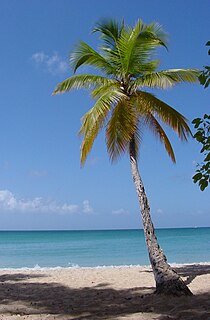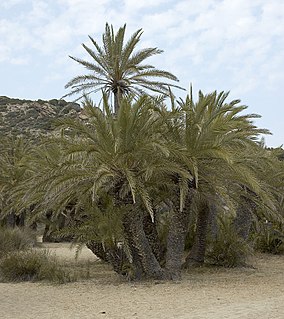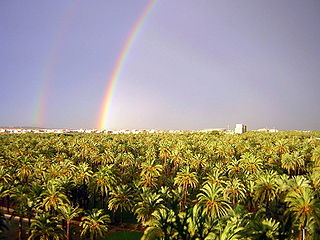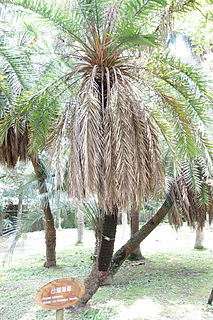
In geography, an oasis is a fertile area in a desert or semi-desert environment. Oases also provide habitats for animals and plants.

The Arecaceae are a botanical family of perennial flowering plants in the monocot order Arecales. Their growth form can be climbers, shrubs, tree-like and stemless plants, all commonly known as palms. Those having a tree-like form are called palm trees. Currently 181 genera with around 2,600 species are known, most of them restricted to tropical and subtropical climates. Most palms are distinguished by their large, compound, evergreen leaves, known as fronds, arranged at the top of an unbranched stem. However, palms exhibit an enormous diversity in physical characteristics and inhabit nearly every type of habitat within their range, from rainforests to deserts.

Phoenix dactylifera, commonly known as date or date palm, is a flowering plant species in the palm family, Arecaceae, cultivated for its edible sweet fruit. Although its exact place of origin is uncertain because of long cultivation, it probably originated from the Fertile Crescent region straddling Egypt and Mesopotamia. The species is widely cultivated across Northern Africa, the Middle East, the Horn of Africa and South Asia, and is naturalized in many tropical and subtropical regions worldwide. P. dactylifera is the type species of genus Phoenix, which contains 12–19 species of wild date palms, and is the major source of commercial production.

Gandia is a city and municipality in the Valencian Community, eastern Spain on the Mediterranean. Gandia is located on the Costa del Azahar, 65 kilometres (40 mi) south of Valencia and 110 km (68 mi) north of Alicante. Vehicles can access the city through road N-332.

Phoenix is a genus of 14 species of palms, native to an area starting from the Canary Islands in the west, across northern and central Africa, to the extreme southeast of Europe (Crete), and continuing throughout southern Asia from Turkey east to southern China and Malaysia. The diverse habitats they occupy include swamps, deserts, and mangrove sea coasts. Most Phoenix species originate in semiarid regions, but usually occur near high groundwater levels, rivers, or springs. The genus is unusual among members of subfamily Coryphoideae in having pinnate, rather than palmate leaves; tribe Caryoteae also have pinnate or bipinnate leaves.

Phoenix roebelenii, with common names of dwarf date palm, pygmy date palm, miniature date palm or just robellini, is a species of date palm native to southeastern Asia, from southwestern China, northern Laos and northern Vietnam,.

Palm sugar is a sweetener derived from any variety of palm tree. Palm sugar is sometimes qualified by the type of palm, as in coconut palm sugar. While sugars from different palms may have slightly different compositions, all are processed similarly and can be used interchangeably.

Phoenix canariensis is a species of flowering plant in the palm family Arecaceae, native to the Canary Islands. It is a relative of Phoenix dactylifera, the true date palm. It is the natural symbol of the Canary Islands, together with the canary Serinus canaria. Mature P. canariensis are often used in ornamental landscaping and are collected and transplanted to their new planting location. A Canary Island date palm with 10 m (30 ft) of trunk is approximately 60 years of age.

Phoenix theophrasti, the Cretan date palm, is a palm native to the eastern Mediterranean, with a very restricted distribution, confined to southern Greece, a few sites on Crete and nearby islands, as well as some places on the Turkish coast. In Europe, with Chamaerops humilis are the unique native palm trees in continental Europe. In Turkey, it is the only native palm species; all the others—although much more common—were introduced.

The Palmeral or Palm Grove of Elche is the generic name for a system of date palm orchards in the city of Elche, Spain. It was planted in Roman times and underwent modifications in the medieval period under Islamic and Christian rulers. The Roman empire introduced water management techniques to Elche, but the 10th c. Islamic Caliphate of Córdoba and later rulers of Al-Andalus planted palm groves and garden-estates in huertos. Islamic rulers also constructed the largest canal system sections in Elche. In the 13th century Christian rulers conquered Elche and expanded the canal system. Industrialization and urban sprawl contracted the Palmeral in the late 19th and 20th century. The Spanish national government and Valencian regional government enacted legislation to protect the Palm Grove. In 2000, UNESCO designated the Palmeral a World Heritage Site, but climate change, pests, and disease threaten the site. The Palmeral includes a National Artistic Garden, Palm Grove Museum, Route of El Palmeral, and Municipal Park.
The Desert Sun is a local daily newspaper serving Palm Springs and the surrounding Coachella Valley in Southern California.

The palm weevil Rhynchophorus ferrugineus is one of two species of snout beetle known as the red palm weevil, Asian palm weevil or sago palm weevil. The adult beetles are relatively large, ranging between two and four centimeters long, and are usually a rusty red colour—but many colour variants exist and have often been classified as different species. Weevil larvae can excavate holes in the trunks of palm trees up to a metre long, thereby weakening and eventually killing the host plant. As a result, the weevil is considered a major pest in palm plantations, including the coconut palm, date palm and oil palm.

Phoenix reclinata, the wild date palm or Senegal date palm, is a species of flowering plant in the palm family native to tropical Africa, the Arabian Peninsula, Madagascar and the Comoro Islands. It is also reportedly naturalized in Florida, Puerto Rico, Bermuda and the Leeward Islands. The plants are found from sea level to 3000 m, in rain forest clearings, monsoonal forests and rocky mountainsides.

Phoenix loureiroi is a species of flowering plant in the palm family, indigenous to southern Asia, from the Philippines, Taiwan, India, southern Bhutan, Burma, Thailand, Cambodia, Vietnam, Pakistan, and China. It occurs in deciduous and evergreen forests and in clear terrain from sea level to 1,500 m altitude.

Phoenix sylvestris also known as silver date palm, Indian date, sugar date palm or wild date palm, is a species of flowering plant in the palm family native to southern Pakistan, most of India, Sri Lanka, Nepal, Bhutan, Myanmar and Bangladesh. It is also reportedly naturalized in Mauritius, the Chagos Archipelago, Puerto Rico and the Leeward Islands. Growing in plains and scrubland up to 1300 m above sea level, the fruit from this palm species is used to make wine and jelly. The sap is tapped and drunk fresh or fermented into toddy. The fresh sap is boiled to make palm jaggery in West Bengal state of India and Bangladesh.

Date sugar is a type of sugar found most commonly in natural food stores since it is less processed than more conventional sugars. It is made from dried dates and adds a rich sweetness to recipes, although it will not dissolve when added to drinks. It also does not melt like granulated sugar which can limit its use. It is sometimes promoted as a healthier alternative to brown sugar, although it can be quite expensive. Date sugar should not to be confused with date palm sugar or also called palm sugar as this is made from the sap of the sugar palm tree, including date trees.
Phoenicococcidae is a family of scale insects commonly known as palm scales or phoenicococcids. There is a single genus containing one species, Phoenicococcus marlatti.

The South American palm weevil, Rhynchophorus palmarum, is a species of snout beetle. The adults are relatively large black beetles of approximately one and a half inch in length, and the larvae may grow to two inches in length.
Diocalandra frumenti, commonly known as the palm weevil borer, the lesser coconut weevil, or four-spotted coconut weevil, is a species of weevil in the family Curculionidae. It occurs in Africa, Southern Asia and Northern Australia, and is a pest of coconut and other palm trees.
Parlatoria blanchardi, the date palm scale, is a species of armored scale insect in the family Diaspididae. It is a widespread and serious pest of palms, both date palms and ornamental species.














